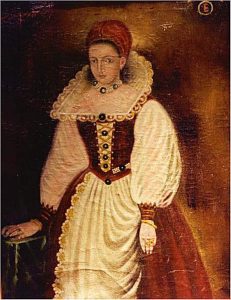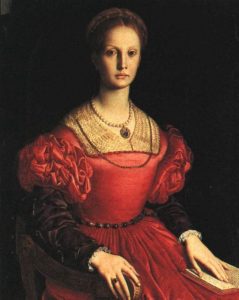
PHOTO: Csejte Castle, szeretlekcsomor.com
Last time on History’s Nutcases, we covered the infamous Vlad the Impaler. This week, we’re not moving very far from our previous destination. We’re still staying in the region of Transylvania and Hungary, and we’re only jumping a hundred years in the future to August 7th, 1560. Our nutcase’s name was Elizabeth Bathory. She’s often nicknamed The Bloody Lady of Csetje, Countess Dracula, and most famously: the Blood Countess. She claimed the lives of over 650 young women over the course of her bloody lifetime, making her the most prolific and vicious female serial killer in history.
Early Life

PHOTO: Wikimedia
Elizabeth Bathory was born to a prominent protestant family on August 7th, 1560. Her relatives included cardinals, knights, and judges. Her father and grandfather had both been prince of Transylvania at one point in their lives, and she was cousin to the Hungarian noble Stefan Bathory, King of Poland. Elizabeth grew up learning Latin, German, and Greek. She was born into a privileged family that owned a lot of land across Transylvania, and held a lot of wealth and power. Unfortunately for Elizabeth, her family tree also held a lot of seriously disturbed people. She was reportedly abused as a child by her aunt, who taught her all about sadomasochism, and one of her uncles apparently instructed her as a Satanist, forcing her to take part in dark rituals in the family castle of Ecsed.
She was engaged at the early age of ten to Ferenc Nadasdy. the son of a Baron. At the age of thirteen, she had a baby by a lover from a lower social strata than her and her betrothed. Ferenc had her lover castrated and then torn apart by dogs. Bathory’s baby, a daughter, was then tucked away and Elizabeth and Ferenc were married in 1575 when she was fourteen. Elizabeth outranked her husband socially, so she kept her surname. They lived at the Nadasdy estates in Hungary at Sarvar and Csejte, but Nadasdy was often away, so Elizabeth was in charge of the estates, had many affairs, and had four children. All of her children were cared for, out of sight, by governesses, just as Elizabeth had been as a child.
Her Crimes
Nobody knows quite exactly when Elizabeth began to take a sick fascination with torturing young girls. One report says that it could have started very early, as her husband apparently built her a torture chamber to her specifications to please his new wife. What we do know is that from roughly 1585, with the help of her husband, old nurse, and a local witch, she began to torture the serving girls in the castle and the local peasant girls. She would tie them down, jam pins and needles under their fingernails and into their lips, and smear them with honey and leave them to be attacked by bees and ants. The count was reported to have participated a lot with his wife’s cruel entertainment, but he may have also restrained her. He died in the early 1600s, when Elizabeth was in her forties, and once Elizabeth Bathory was in full control of her late husband’s estates, her torture began to violently escalate.
She began to abduct peasant girls to torture and kill. Witnesses said that she often bit chunks of flesh off of her victim’s arms, legs, faces, and breasts. Some were starved to death; some were beaten to death. One girl was even forced to cook and eat her own flesh in front of Bathory.
But, believe it or not, Elizabeth is not most infamous for these cruelties. She had one even darker obsession: an obsession with human blood, specifically the blood of young, pretty girls. She apparently thought that drinking human blood would make her younger, virulent, more beautiful, and, perhaps, even immortal. Elizabeth reportedly drained her victims and drank their blood, and there’s even stories of her inventing an apparatus to drain the blood from the floor of her torture chamber into her bathtub for her to bathe in, though that story may have been added later in folklore.
Investigation and Arrest
Because of her family connections, Elizabeth was powerful. She was untouchable. No peasant within a hundred miles of the estate dared to raise any accusations against the Blood Countess. But, between 1602 and 1604, rumors of Bathory’s atrocities began to spread. It was not until Elizabeth went too far, according to other nobility, when she began to torture young girls of noble birth who had been sent to her to learn ettiquette that any investigation was raised. A Lutheran minister made public complaints about her, and finally, in 1610, King Matthias II assigned György Thurzó to investigate the claims made against Elizabeth. Thurzó ordered two notaries to collect evidence in March of 1610. In 1610 and 1611, they collected evidence from more than 300 witnesses. They included the castellan and other personnel of Elizabeth’s castle.

Elizabeth’s Coat of Arms. PHOTO: Wikimedia
All of the witnesses agreed that Bathory’s initial victims were adolescent daughters of local peasants who she lured to the castle with promises of well-paid work. And they all agreed that she later began to murder the daughters of lesser gentry and that she began to abduct young women from around Csejte. Two witnesses said they actually saw Elizabeth torture and kill serving girls, and others reported that they’d seen physical evidence on bodies buried in Csetje’s graveyard.
On this evidence, Thurzó went to Csejte Castle on December 30, 1610. What he found there was bone chilling: Elizabeth’s blood-soaked torture chamber, one girl dead, another dying, and another women found wounded. Scores of girls were locked up in rooms. They found Bathory’s equipment, the goblets she used to drink blood in, and other physical evidence. The stench of death and blood pervaded the rooms she used to murder her victims. They put Bathory and her accomplices under house arrest.
The king urged Thurzó to bring her to trial and execute her, but Thurzó convinced the king otherwise. It would reflect badly on the nobility, he said. Instead, they locked her away in a castle, in solitary confinement. She was kept bricked in a set of rooms, with only small slits left open for ventilation and the passing of food. On August 21, 1614, she complained to one of her guards that her hands were cold, to which they replied: “It’s nothing, Mistress. Just go lie down.”
Death and Folklore
She went to sleep and never woke up. Elizabeth was found dead the following morning. She was originally buried in a church on November 25 of the same year, but the villagers had a fit, and her body was moved to the place of her birth at Ecsed, where it was interred in the Bathory family crypt.
Her story melted into the popular folklore of the time, and has inspired ghost and vampire stories for decades. Nobody quite knows why Elizabeth turned into such a vicious, bloody serial killer. Some think she was demon-possessed, and some think she somehow knew that she was iron deficient and that she thought drinking blood would cure it. Those are more of the far-fetched theories. Most experts attribute her sadism to her cold, frightening childhood in Ecsed, to the abuse inflicted on her by her aunt, and to the rituals her uncle forced her to take part in as a young girl. Like most serial killers, Elizabeth probably started by killing and torturing small animals as a child.
Her legend has persisted throughout the years since her death. Though one man, Joseph Zsuffa, wrote a scholarly biographical novel in 2015 in an attempt to separate folklore from truth and exonerate Elizabeth Bathory from all of the charges she was accused of, the evidence against the countess is too overwhelming. There are an estimated one hundred bodies buried at Csejte Castle, with more in the other estates owned by Elizabeth and her family. As long as those bodies and the paperwork and accounts exist, Elizabeth Bathory will always be remembered as one of the most notorious female serial killers of all time, immortally as the infamous “Blood Countess.”



